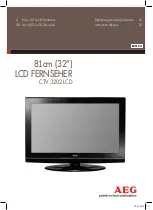
Important safety instructions
5
Lightning
For added protection for your TV’s receiver during a lightning storm, or
when it is left unattended and unused for long periods of time, unplug
it from the power outlet and disconnect the antenna or cable system.
This helps prevent damage to your TV from lightning and power line
surges.
Screen protection
Your TV’s screen is made of glass. Do not drop your TV or hit the glass
screen. If the screen breaks, be careful of broken glass.
Pixel defect
Your TV’s screen is designed to display finely detailed pictures.
Occasionally, a few non-active pixels may appear on the screen as fixed
points of blue, green, or red. This is not a defect and does not affect your
TV’s performance.
Power lines
An outside antenna system should not be located in the vicinity of
overhead power lines or other electric light of power circuits, or where it
can fall into such power lines or circuits.
When installing an outside antenna system, extreme care should be
taken to keep from touching such power lines or circuits as contact with
them might be fatal.
Temperature
Do not use in hot or cold locations. If you use your TV in a cold location,
the picture may leave trails or appear slightly delayed. This is not a
malfunction. Your TV will return to normal operation when the
temperature returns to normal.
Do not leave your TV in a hot or cold location. Do not install your TV in a
location that is exposed to direct sunlight or near a heater. The cabinet
may warp and the screen may malfunction.
Storage temperature: 32°F to 122°F (0°C to 50°C)
Operating temperature: 41°F to 104°F (5°C to 40°C)
Non-active pixels
The LCD panel contains almost 3 million thin film transistors, which
provide exceptionally sharp video quality. Occasionally, a few nonactive
pixels may appear on the screen as a fixed blue, green, or red point.
These non-active pixels do not adversely affect the performance of your
TV, and are not considered defects.
After Image
If you display a fixed image on the screen for an extended amount of
time, a permanent after image may be burned into the screen. To avoid
this type of damage:
• Reduce the brightness and contrast settings to a minimum
viewing level.
• Do no display a fixed image for extended period of time.
Examples of fixed images include logos, video games, computer
images, teletext, and images displayed in 4:3 mode. This type of
damage is not covered by your warranty.
• Turn off your TV when it is not in use
Outdoor antenna grounding
If an outside antenna or cable system is connected to your TV, make sure
that the antenna or cable system is grounded to provide some
protection against voltage surges and built-up static charges. Article
810 of the National Electrical Code, ANSI/NFPA No. 70, provides
information with respect to correct grounding of the mast and
supporting structure, grounding of the lead-in wire to an antenna
discharge unit, size of grounding conductors, location of the
antenna-discharge unit, connection to grounding electrodes, and
requirements for the grounding electrode.
Note to CATV system installer
This reminder is provided to call the CATV system installer’s attention to
Article 820-40 of the NEC that provides guidelines for correct grounding
and in particular, specifies that the cable ground must be connected to
the grounding system of the building as close to the point of cable entry
as practical.
1
Electric service equipment
2
Power service grounding electrode system
3
Ground clamps
4
Grounding conductors
5
Antenna discharge unit
6
Grounding clamp
7
Antenna lead-in wire
6
7
5
2
1
3
4






































